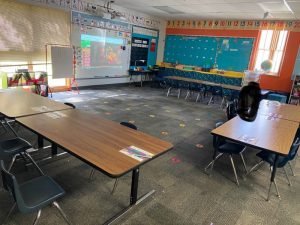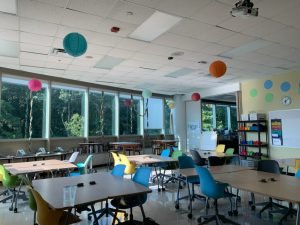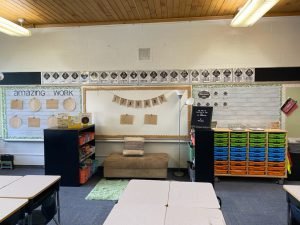
Without a doubt, designing your classroom for learning takes some work.
Tips for designing your classroom around your students
Designing your classroom is a big deal. Marcia Roher and Nannette Samson spent a lot of time discussing classroom layout in their book: 10 Critical Components for Success in the Special Education Classroom. While their content is geared for special education classrooms, their strategies and ideas can be applied to broad contexts.
Roher and Samson give a clear defense for spending time and resources on classroom layout. First of all, defining and clarifying the classroom space is considerate. Your students will want to anticipate what’s happening next. This undoubtedly helps student behavior and participation.
“Your classroom space is valuable real estate,” Roher and Samson assert. “This means that every square foot needs to be used for activities that support student learning. Its use should be maximized.”
Roher and Samson encourage their readers to ask themselves the following questions:
- Is this the best use of this space?
- Does the way I’m using this space help contribute to the success of my students?
What should teachers consider when setting up their classrooms?

Plan for smooth transitions.
Dr. Kyle Chuhran, Ed.D., shares his favorite tip below.
“There is no one right way to set up a classroom, but everything needs to be set up to make transitions smooth and less time-consuming. Students need to be able to enter, exit, access materials, change to small group settings, etc. quickly and with minimal disruption. Of course, part of this is also teaching students the procedures for all of these activities and transitions. When students know the routines, there is less opportunity for discipline issues as well as minimal loss of instruction time.”

How interactive do you want your students to be?
Concordia’s Dean of the School of Education, Jim Pingel, Ph.D., states: “Teachers should consider how interactive they want their students to be. Rows aren’t good for student interaction, but they’re good for demonstrations. Organizing the room in pods, circles, centers, or collaborative tables may work better for some classes than others. They need to design their seating arrangements accordingly.”
Pingel notes that considering the teacher’s needs is important, too. “Teachers should feel free to roam and flow throughout a classroom. No one wants a cramped room. So, how can you configure a room that is as safe, open, and as inviting as possible?”

How will this space be used?
Jennifer Bueby, OTD, OTRL, is Concordia University Ann Arbor’s Academic Fieldwork Coordinator for the Occupational Therapy program. When it comes to classroom space, Bueby said gave some layout tips.
Determine if your classroom will be lecture or discussion-focused.
“If the class is lecture-focused,” she said, “the instructor should position tables/desks and chairs to all be facing toward the front of the classroom. However, if your class involves a considerable amount of student discussion, instructors should position desks in a circle where all students are facing toward the center of the circle.”
Bueby continued: “Sitting in a circle facing others not only reduces head rotation/spine rotation when making eye contact with a student speaker (which can cause pain and inflammation if the student is in an unnatural position), but encourages students to participate.”
Let there be light.
Finally, Pingel adds, “Teachers should always be cognizant of light.” Research generally shows the brighter the room, especially if it is natural light, the better. There are exceptions to this, of course, especially for particular lessons. But light, colors on the wall, etc. should all be considered and rectified.

Put yourself in your students’ shoes.
Dr. Sara Clemm von Hohenberg, whose experience is in secondary education, offers this tip: “Teachers should think as if they were a student in their own classroom.”
She advises teacher education students to ask these questions when designing their classrooms:
- Are supplies accessible?
- Is the room welcoming?
- Would I feel comfortable in this room?
- Are there distracting decorations?
- Are the most important things (class rules, objectives for the day, daily schedule, etc.) in the front of the room?
Flexible layouts allow for endless possibilities.
Dr. Chuhran, who has experience as a classroom teacher, music teacher, and administrator, shares his perspective: “I like room designs that can quickly be changed during a class period or on a day-to-day basis. For tests, I like to be able spread everyone out as far as possible so no distractions will occur.”
Chuhran adds, “Sometimes rows are good for the 15-minute lecture discussion, but then I want them to process what they were taught in a reflective manner. Maybe, I want them to have a conversation with their peers in a group of four. Can the furniture, floor, and classroom layout allow this change to happen as quickly and smoothly (with limited noise) as possible? So I really like rooms that can be redesigned and repartitioned quickly.”
Flexible seating and teacher desk position
Clemm von Hohenberg loves flexible seating in her classrooms. She notes: “I always liked having my desk at the back of the room so that students felt comfortable coming and asking me questions without the whole class looking at them.”
Additionally, Dr. Clemm von Hohenberg admitted to learning this lesson the hard way: “Keep turn-in bins in the front of the room.” (Students could easily take other student’s work.) When it comes to seating, Clemm von Hohenberg is a huge proponent of bean bags, couches, and other comfy items around the periphery of the room. “I would change my desk configuration every couple of weeks,” she noted, “This allows students to interact in different ways.”
We want to hear from you!
What works best for you and your students? When it comes to your classroom layout, what do you prefer? There are a lot of ways to set up a classroom effectively. If you’re not loving the way your classroom is set up, it’s okay to make a change. For inspiration, check out how some of our community members set up their classrooms.
Aric Foster, English, Armada High School

Kali Hill, Kindergarten, Fortis Academy


Allyson Sovis, Science, Skyline High School

Halle Oatridge, Westfield Academy, Kindergarten


— Vanessa Lane is the Content Marketing Lead at Concordia University and can be reached at vanessa.lane@cuaa.edu. When she's not at work, she can be found playing with her kids or watching NBA basketball with her husband.
If this story has inspired you, why not explore how you can help further Concordia's mission through giving.